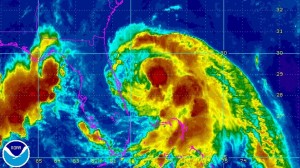As the first big Atlantic storm of the year bears down on the North Carolina coast, all bets are off for what had been looking to be a record weekend for travel, especially among those expecting to drive over the long Fourth of July holiday.
Overall, a survey by the AAA found 41 million people ready to travel, whether by air, rail or car, an increase of 1.9%. The national organization also noted that about 80% of those who plan to leave home will do so by automobile – or 34.8 million, the biggest number since 2007, before the Great Recession began.
A separate survey, conducted for Hankook Tires, was even more optimistic, predicting a 9% jump in travel for the long holiday – which is defined this year as beginning on Wednesday, July 2nd and ending on Sunday, July 6th.
The tire company’s study also found 69% of Americans planning to take a road trip sometime over the summer, with the average journey expected to be about 909 miles.
About 3.1 million Americans are forecast to skip the drive and fly to their destinations, according to AAA, a 1% year-over-year increase.
(US auto industry obliterates old one-year recall record – in just six months. Click Here for the full story.)
But plans could change if Tropical Storm Arthur continues to bear down on the East Coast, North Carolina currently expected to be in the storm’s crosshairs. Arthur was expected to turn into a full-blown hurricane by sometime on Thursday. If anything, some of those traveling could be fleeing the weather’s wrath, a mandatory evacuation order already in effect for Hatteras Island.
The storm’s effects could spread for 100s of miles, however, dampening Fourth of July plans as far away as Washington, D.C., weather forecasters warned. A AAA spokesperson warned that those traveling along much of the East Coast could be “staring down the barrel of a loaded gun.”
Those who do travel will likely find themselves paying almost 20 cents a gallon more for fuel than they did a year ago, according to GasBuddy.com, a website that tracks fuel price trends across the country. At an average $3.678 for a gallon of self-serve unleaded regular, the price is up about three cents from this time last month but actually down a couple pennies from a week ago, when nervous oil traders were responding to fears that Islamist rebels might be marching on Baghdad.
The lowest prices in the country were in South Carolina as the holiday began, an average of $3.359, according to GasBuddy, with the highest figure in Hawaii, at $4.366. But for the mainland, California topped the list at $4.116.
(Rising fuel prices fail to dampen demand for new cars, but June sees rising sales of high-mileage models. Click Here for the story.)
Experts suggest motorists planning a weekend trip take time to prepare and avoid common mishaps:
- Check tire pressures in the morning before a trip to ensure proper inflation, which will improve fuel economy and reduce the risk of blow-outs and premature wear;
- Also check radiator and other fluid levels, as well as brakes and head and taillights;
- Pack an emergency kit with such useful accessories as spare fluids, a flashlight, jumper cables, sunscreen and bottled water;
- If you’ll carry a luggage or bicycle rack, make sure everything is properly secured; and be certain your hitch is in good shape if you’re towing a trailer.
It’s also useful to bring along maps or a portable navigation device, especially if you’re on a long trip to unfamiliar territory.
Avoid risky behaviors, such as texting behind the wheel, which can be especially dangerous when roads are crowded. The biggest hazard over the holiday? Drinking and driving which, reports the National Highway Traffic Safety Administration, is responsible for 44% of Fourth of July roadway fatalities.
(Dodge delivers most powerful muscle car ever, 707 hp Challenger Hellcat. Click Hereto check it out.)


